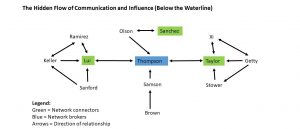How do communications and influence flow through your organization? The most obvious and visible method is through formal channels. Leaders in corporate or business-line roles receive information from executives and these leaders cascade the information down the hierarchy through predictable channels like email and town hall and group meetings. The path of these communications can be easily traced down through the lines and boxes of an organization chart.  However, communication and influence that flows through informal networks can also be more subtle and less visible. These networks form through a web of relationships founded on many reasons. While people may sit far apart on the formal organization chart, some of these people may be close friends and easily influence each other because they carpool together, worked together in the same department years ago, their kids attend the same school, play golf every Saturday, belong to the same extended family – and the list of possible connections goes on.
However, communication and influence that flows through informal networks can also be more subtle and less visible. These networks form through a web of relationships founded on many reasons. While people may sit far apart on the formal organization chart, some of these people may be close friends and easily influence each other because they carpool together, worked together in the same department years ago, their kids attend the same school, play golf every Saturday, belong to the same extended family – and the list of possible connections goes on.
While organization charts show the formal structure of hierarchy, communication, and influence, leaders often lack a map of the informal networks in their organization. These maps can show who we trust, who we seek out for advice, and who comes to us for advice. A map that shows these connections would not only look different from the formal organization chart, but also be very useful when developing an organizational change plan.
As a consultant, I have conducted social network analysis studies with operations and senior leadership teams. After leaders and employees complete a short survey, I generate network maps with the help of network mapping software. As I share the results, leaders are often surprised by two common patterns that emerge. First, network maps identify people who serve as “brokers”. Employees in the broker role are often very influential and serve as a bridge between subgroups within network. The broker role is represented in blue in the chart below. 
Brokers have relationships with different subgroups that help them position themselves to knit together an entire network and make these interactions as the most efficient means to gather and share information. According to research, brokers often have the best perspective on what aspects of a change will work across different subgroups. Also, brokers have a high degree of ground-level credibility with people from different functions, locations, or roles. Thus, leaders should seek out brokers in their organization to serve as early adopters and advocates for change. (1) In the examples above, Thompson works in R&D in a non-leadership role, but Lui and Taylor in Sales and Corporate HQ have trust and positive relationships with Thompson that enable Thompson to bridge the two teams where the trust and relationship between the leaders of these three teams is not sufficiently strong enough.
The second important pattern to emerge is people in the “connector” role as represented in green in the above chart. Similar to the broker role, connectors are influential within informal networks because they are considered the “go-to” people for information, advice, and insights. (2) Connectors often have long tenure with the organization and have extensive knowledge of and relationships within the organization. In the examples above, Lui and Taylor are not formal leaders, but considered the go-to people by their coworkers. Sanchez is not in a formal leadership role, but considered a trusted advisor to Olson the executive. These people play an important role in connecting others with advice and answers to make decisions.
Bottom Line: Brokers and connectors are not formal titles or positions in an organization chart. However, these roles emerge in organizations in order for people to get their work done – often outside the lines and boxes of the formal organizational structure. When leading organizational change, leaders who invest the time and energy to map and understand their informal networks and collaborative relationships before starting their change initiative will find hidden, but trusted partners and allies to help them influence the right people in unexpected ways to successfully meet the outcomes of their change initiative.
Sources:
- https://www.mckinsey.com/business-functions/organization/our-insights/the-role-of-networks-in-organizational-change
- The Hidden Power of Social Networks: Understanding How Work Really Gets Done in Organizations (2004 – 4th Edition). Rob Cross and Andrew Parker

